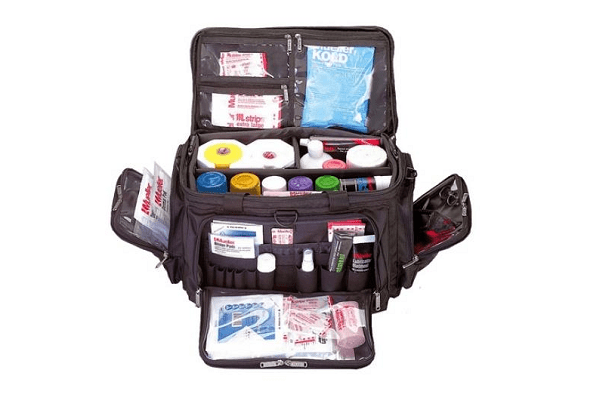Rest turned into disease >>>> First aid kit on the road
First aid kit on the road.

No matter how far from home you are, you should always have a certain set of medicines and medical supplies with you to dress a wound or stop bleeding. Medicines are especially important when you are planning a vacation in places remote from medical institutions or abroad.
There is a minimum required amount of medicines included in a standard first-aid kit, which is advisable to have with you even for an absolutely healthy person.
A first aid kit for the trip should include:
-
Medicines:
- Adrenaline for injection (used for developing anaphylactic shock or other allergic reactions of an immediate type (for example, urticarial, Quincke edema) in the presence of 2-3 ampoules,
- Prednisolone (a hormonal corticosteroid - for anaphylactic shock and other types of shock, with an acute attack of bronchial asthma) in the presence of 2-3 ampoules,
- Suprastin, Tavegil or Diphenhydramine (desensitizing agent - against allergies) available in cash, packaging, ampoules,
- Analgesics (Analgin in ampoules or tablets, Tempalgin, Baralgin or other available analgesics) in the presence of 10 ampoules or a pack,
- Antispasmodics (No-spa),
- Diuretics (Furosemide or others - reduce blood pressure and relieve swelling) in the presence of a currency, packaging,
- Reducing pressure (Kapoten) in the presence of a currency, packaging,
- Nitroglycerin ( angina pectoris),
- Anticonvulsants (Relanium),
- In case of violation of the rhythm of the heart - arrhythmias (Panangin) in the presence of currency, packaging,
- Isotonic 0.9% sodium chloride solution for injection in ampoules,
- Activated carbon (for poisoning, gastrointestinal disorders, dyspepsia),
- Aspirin,
- Albucid (bacteriostatic eye drops).
Medical supplies:
- Ammonia,
- Disposable syringes,
- Pipette (several pieces),
- Sterile and non-sterile bandage,
- Individual dressing sterile package,
- Medical sterile gauze wipes,
- Cotton wool,
- Adhesive plaster of different widths, including bactericidal,
- Elastic bandage,
- Large pins to secure the dressing,
- Harness,
- Breathing bag "AMBU",
- Medical glue BF-6,
- Antiseptics (Iodine and Hydrogen Peroxide).
To this impressive list it is worth adding:
- anti-burn agents (Panthenol or other creams),
- laxatives (Senade or others),
- anti-diarrhea drugs (Immodium or others),
- pills or spray for sore throat (for example, Strepsils Plus spray),
- insect bite sprays or ointments,
- means against motion sickness,
- contraceptives.
And finally, it is necessary to replenish the first-aid kit with those drugs that you take regularly (daily or periodically) in the treatment of your chronic diseases.
It must be remembered that all drugs have contraindications that must be correlated with your health condition. Instructions for each drug must be enclosed in a package (box) or attached with an elastic band to the container, bottle. It is also necessary to pay attention to the storage conditions of some drugs: for example, it is better to keep adrenaline in a cool place (ideally, in a refrigerator, refrigerator bag).
When traveling abroad in a first-aid kit, all drugs must be enclosed in boxes, vials (or other containers) in which they were sold (original factory packaging). Medicines should be in an amount not exceeding the dose of their use for the entire period of the trip.
Some medicines are strictly prohibited for transportation across the border: narcotic drugs, psychotropic drugs, some analgesics. In case of an urgent need to replenish the first-aid kit with drugs prohibited for export, you need to have a doctor's prescription or an extract from the medical history certified by a doctor (plus a translation of the prescription or extract into the language of the country of visit), a receipt for the purchase of the medicine, confirming its legal purchase. Prohibited drugs required for treatment must be declared. It is better to declare all prescription drugs.
Transportation of antibiotics can also cause problems, but not always and not to all countries. If you need to take insulin with you, then a doctor's prescription or an extract from the medical history will not interfere so that there are no problems at customs.
When flying, it is better to check the first-aid kit in your luggage, leaving only those medications for yourself that you may need in the aircraft cabin, since you are unlikely to be allowed to have liquid medications on board (with the exception of insulin and similar medications).
Even if you think that all the funds included in the first-aid kit are a rather heavy burden, you still need to take it with you, especially when traveling abroad, where medicines are dispensed with prescriptions, and getting something from a local pharmacy will be difficult. It is better to take less clothes in your luggage than to be left in difficult times without medical supplies and medicines that can save your health, and sometimes even your life.

Read

Read



























